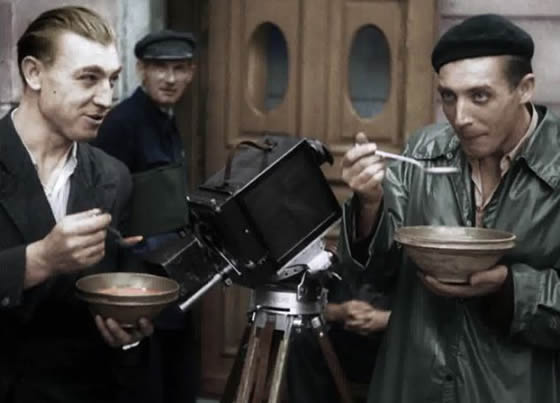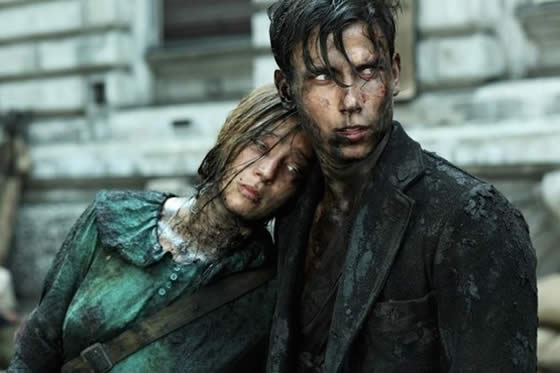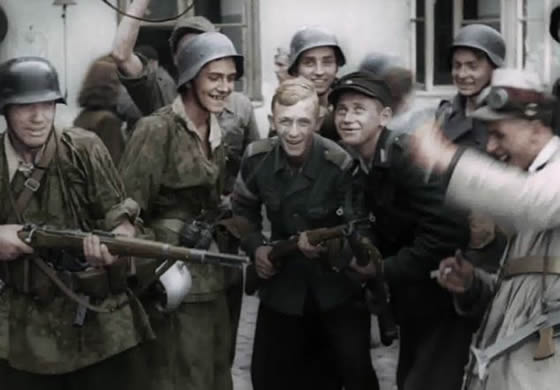 During the six year duration of World War II, as the German armies caused havoc throughout Europe and, indeed, the world, there was only one city that stood up in an uprising against the occupiers. That city was Warsaw, Poland which fought off the German armies for two months in Aug/Sept. of 1944. The Poles sent out a camera crew to document the epoch struggle. Over eight hours of footage, all silent, was collected and found throughout Europe in the years following the War.
During the six year duration of World War II, as the German armies caused havoc throughout Europe and, indeed, the world, there was only one city that stood up in an uprising against the occupiers. That city was Warsaw, Poland which fought off the German armies for two months in Aug/Sept. of 1944. The Poles sent out a camera crew to document the epoch struggle. Over eight hours of footage, all silent, was collected and found throughout Europe in the years following the War.
To honor the military and civilians that fought and died that summer (it is estimated that over 200,000 Warsaw citizens, about 20% of the city’s total population perished) the Warsaw Uprising Museum has produced a documentary about this tragic period in the country’s history. Using the latest in technical achievements (including colorization, and rendering to read the subject’s lips with actors recording the dialogue), the partisans of the struggle are – literally – given voice once again. All the footage in the movie is real and taken by a camera crew that shot the film at that time.
WARSAW UPRISING was directed by Jan Komasa whose film SUICIDE ROOM was an international festival success two years ago. The producers of the film are Jan Oldakowski and Piotr C Sliwowski. Cinematographer Piotr Sobocinski Jr is responsible for the technical accomplishments of the film.
Bijan Tehrani: How did you come up with the idea of making Warsaw Uprising?
Jan Komasa: It was four year ago when Piotr Sliwowski and his fellow director from Warsaw, Jan Oldakowski – they are both directors of the Warsaw Uprising Museum -approached me and said they had something really special. They showed me a clip, a sample of the footage they had and the footage was just one shot from the Uprising archives. It was colorized and when I saw it I was amazed. I said “what is going on? Why are you showing this to me?” They said we have more of it and we would like you to make a movie out of it, what do you think? I said, sure without any hesitation. I was personally interested in it because of my other project; 8 years before I was approached by different producers to make a dramatic feature about the Warsaw Uprising. We started to work on this and I began the research and because of the budget of that movie, it was being postponed each year. It was continually postponed, and the shooting was impossible because we did not have enough money. So after four years of nothing, this documentary was proposed instead. We, at first, did not know how the story would be told. Initially, it was supposed to be a simple documentary with commentary from behind the camera. Then the second thought was that maybe we could make something else that was a hybrid between a feature film and a documentary, that I could shoot some scenes with actors and it could complete the material with what was missing. Finally I thought that we should make the movie completely 100% out of the historical footage we had, if that would be the goal to limit ourselves to just exactly this footage. This would be something really special and I decided to take the chance and I said ok. The WWII footage we use was shot by multiple different teams. The teams were comprised of a director of  photography, a director and someone who helped them with the equipment. Each team had its own issues. In all, about six hours of footage was usable. There was no patterns in the direction, but the footage was shot by real people in extreme conditions. That was my goal, to show the people who shot this footage and therefore I knew I had the first initial idea to make the main characters out of the cinematographers who shot it. The second thing was to find out everything possible about the cinematographers and talk to anyone who knew about them and how they shot the footage, who took part in the shooting, and so on. Unfortunately everyone had passed away, so we could not find anyone to talk to. We had only memoirs and the kind of reports and a couple of sentences from some interviews with them and nothing more. But out of it we learned that there was one pair of cinematographers. They were a team of brothers and one of the brothers was critically wounded, and so we decided that this was something we could use. We would see the footage and hear them talking throughout the whole film and, thanks to that, we can have the context of what is being shot by the brothers, their conflict, and their drama. After that, it was just a matter of creating a story line. The storyline came to me really quickly because I was interested in shooting a movie about this topic before. We started to look for characters and we came up with actors and people who also were trying to add everything possible to characters in order to make it appealing for the viewer. I did not want, by any means, the fictional story behind it to cover the real jewel and diamond in the footage we had that and no one saw before. From the beginning we were looking for a reason to show to the audience in a believable way; we wanted to show the agony of a dying city and a dying civilization and a dying world, and every viewer can relate to this idea.
photography, a director and someone who helped them with the equipment. Each team had its own issues. In all, about six hours of footage was usable. There was no patterns in the direction, but the footage was shot by real people in extreme conditions. That was my goal, to show the people who shot this footage and therefore I knew I had the first initial idea to make the main characters out of the cinematographers who shot it. The second thing was to find out everything possible about the cinematographers and talk to anyone who knew about them and how they shot the footage, who took part in the shooting, and so on. Unfortunately everyone had passed away, so we could not find anyone to talk to. We had only memoirs and the kind of reports and a couple of sentences from some interviews with them and nothing more. But out of it we learned that there was one pair of cinematographers. They were a team of brothers and one of the brothers was critically wounded, and so we decided that this was something we could use. We would see the footage and hear them talking throughout the whole film and, thanks to that, we can have the context of what is being shot by the brothers, their conflict, and their drama. After that, it was just a matter of creating a story line. The storyline came to me really quickly because I was interested in shooting a movie about this topic before. We started to look for characters and we came up with actors and people who also were trying to add everything possible to characters in order to make it appealing for the viewer. I did not want, by any means, the fictional story behind it to cover the real jewel and diamond in the footage we had that and no one saw before. From the beginning we were looking for a reason to show to the audience in a believable way; we wanted to show the agony of a dying city and a dying civilization and a dying world, and every viewer can relate to this idea.
BT: It is very interesting and touching and when watching the film it is hard to believe that this is real footage, what was the process of cleaning and colorizing the archival footage? JK: The initial step was to select the footage. The restoration process and putting color to it is very expensive and time consuming. First, we wanted to collect the footage which we thought the most interesting, that was the most accurate for the story to be told. That’s why we had during the first offline, we had 130 minutes of the story and then we cut and gradually we cut it down to the length (87 minutes) that we have today. Once we had the all the material we wanted to use in the movie, we activated our team and a post productions company in Poland that is the best at restoring such material. Orca was the firm that worked on and restored the material and that was also something that was a difficult decision, because there was multiple things in the material that I wanted to keep and several mistakes that I did not want to restore. If the camera was shaky, or the lens was dirty, I wanted to keep it, because that was authentic and it is what the characters actually did in real life. I wanted to keep it and I did not want anyone to restore or correct it. The vast majority of the material has some sort of mistakes that I kept them from restoring, because I thought that the mistakes brought an authenticity to the film. They were trying to establish the look of the movie, the right contrast, painting the footage and trying to have a clear view as possible and at the very end we said ok that’s the quality of the picture we like. The second phase was sending the film to San Francisco to be colorized. This was difficult because we needed people who were experienced enough to know the colors of the fabrics, the buildings, the street signs and everything that we see in the movie. If they came up with a scene or a shot it might take some cropping. The did try to find the same clothing in their warehouses because they had a lot of items and if they found it, they were making a photo out of it and sent it to everybody and they had a server for everything. After a couple of months on the server, there were multiple gigabytes of just photos, a database of everything that we could have in the movie and how it should look. The last phase we called the simple colorization process, where I was working with a cinematographer to establish a loop for the movie, to just have one style for all 87 minutes of the film. I needed the same skin tones, manipulated scenes containing much heavier and more brutal material. We wanted to show the brutality in Warsaw during this time and we were manipulating the color once we established it for everything.
JK: The initial step was to select the footage. The restoration process and putting color to it is very expensive and time consuming. First, we wanted to collect the footage which we thought the most interesting, that was the most accurate for the story to be told. That’s why we had during the first offline, we had 130 minutes of the story and then we cut and gradually we cut it down to the length (87 minutes) that we have today. Once we had the all the material we wanted to use in the movie, we activated our team and a post productions company in Poland that is the best at restoring such material. Orca was the firm that worked on and restored the material and that was also something that was a difficult decision, because there was multiple things in the material that I wanted to keep and several mistakes that I did not want to restore. If the camera was shaky, or the lens was dirty, I wanted to keep it, because that was authentic and it is what the characters actually did in real life. I wanted to keep it and I did not want anyone to restore or correct it. The vast majority of the material has some sort of mistakes that I kept them from restoring, because I thought that the mistakes brought an authenticity to the film. They were trying to establish the look of the movie, the right contrast, painting the footage and trying to have a clear view as possible and at the very end we said ok that’s the quality of the picture we like. The second phase was sending the film to San Francisco to be colorized. This was difficult because we needed people who were experienced enough to know the colors of the fabrics, the buildings, the street signs and everything that we see in the movie. If they came up with a scene or a shot it might take some cropping. The did try to find the same clothing in their warehouses because they had a lot of items and if they found it, they were making a photo out of it and sent it to everybody and they had a server for everything. After a couple of months on the server, there were multiple gigabytes of just photos, a database of everything that we could have in the movie and how it should look. The last phase we called the simple colorization process, where I was working with a cinematographer to establish a loop for the movie, to just have one style for all 87 minutes of the film. I needed the same skin tones, manipulated scenes containing much heavier and more brutal material. We wanted to show the brutality in Warsaw during this time and we were manipulating the color once we established it for everything.
BT: Will this film be entered in the documentary category at the Academy Awards?
JK: That is why we are here in Los Angeles. We started to show the movie to be considered in competition and we think that the power of the movie is that it is unique and there is no film like this. It is a mixture and an experiment. It is, in our opinion, something completely original and new. So for the first time in the world, there is a documentary like this and, from the producers’ point of view, it was madness to make this kind of movie because you did not know where it will end up at the end.

